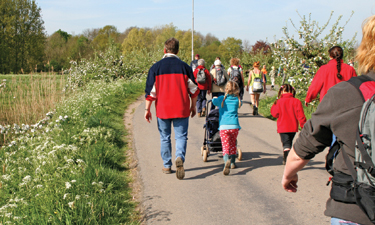 There has been a major development in health and medicine — the discovery of a treatment that is not only safe, easy and fun, but has been known to reduce the incidence of heart disease and blood pressure, decrease symptoms of depression, and save Americans billions of dollars a year. And it’s free. It’s called walking.
There has been a major development in health and medicine — the discovery of a treatment that is not only safe, easy and fun, but has been known to reduce the incidence of heart disease and blood pressure, decrease symptoms of depression, and save Americans billions of dollars a year. And it’s free. It’s called walking.
Walking is the most popular form of physical activity in the United States. Although studies show that fewer trips today are made by walking and biking and that the percentage of children walking to school today is less than 40 years ago, according to the recent A Walking Revolution report, Americans are walking much more than they realize. In an effort to encourage people to walk more and to build policies and strategies that will make communities everywhere more walkable, the U.S. Surgeon General Dr. Regina Benjamin recently announced that she will be issuing a call to action on walking. This has compelled groups such as park and recreation agencies to re-examine barriers to walking for all people and implement evidence-based strategies to overcome those barriers.
People who reside close to parks and open spaces are approximately two to three times more likely to take a walk within a two-day period than their counterparts who have no parks near their home. For this reason, efforts to enhance accessibility to parks and trails as a means of promoting walkable communities are critical, but a number of obstacles exist. Disparities in the distribution of and access to public parks and trails impede walkable communities. People are more likely to walk when they feel protected from traffic and safe from crime and hazards. Trails should be properly maintained to avoid injury and provide a safe environment for wheelchairs, strollers and the visually impaired. People need to know where to find safe and convenient places to walk in their communities.
Local park and recreation agencies are working to overcome barriers by working with community partners to develop evidence-based policies and changes to the environment that support walkability. In Corpus Christi, Texas, the city made a commitment to develop a hike and bike Master Plan. Louisville, Kentucky, Metro Parks is working with local and national partners to develop a 100-mile trail system that will encircle the city, linking parks and neighborhoods to civic and cultural attractions and providing healthy transportation options for residents. The West Virginia Recreation and Park Association is working in collaboration with the Mid-Ohio Valley Health Department to establish a comprehensive trail marking and identification system that will include signs for every type of trail usage.
The long-term health benefits of walking are clear and can help Americans reach important physical activity goals such as those outlined in the 2008 Physical Activity Guidelines and Midcourse Report. Enhancing walking infrastructure not only positively impacts communities through improved physical health, but also boosts local economies and the sustainability of our environment. A Walking Revolution also reports that walking brings a host of other benefits, including a greater appreciation of local, state and national parks; open space; and recreation centers. Parks and recreation are a solution to the barriers that currently prevent walking and, by supporting and promoting walking and walkable communities, can help build a healthier and fit nation.
To support the Surgeon General’s call to action, a Walking Summit is planned for October 2013 in Washington, D.C. The “Every Body Walk!” campaign, which was catalyzed by Kaiser Permanente to get Americans moving and make communities more walkable, has become a collaborative involving numerous organizations, including NRPA. America Walks, a national coalition of local walking advocacy groups, serves as the collaborative’s coordinator.
Zarnaaz Bashir, MPH, is NRPA’s Director of Strategic Health Initiatives.
Walk Your Way to Good Health
June 1, 2013, Department, by Zarnaaz Bashir, MPH

